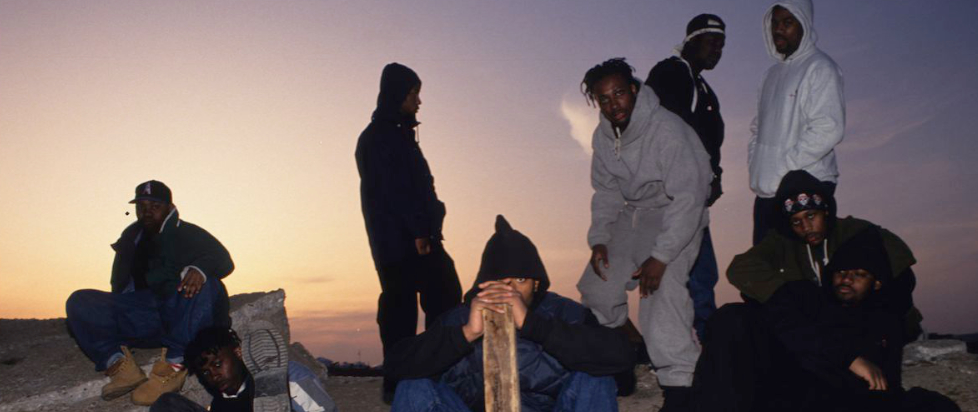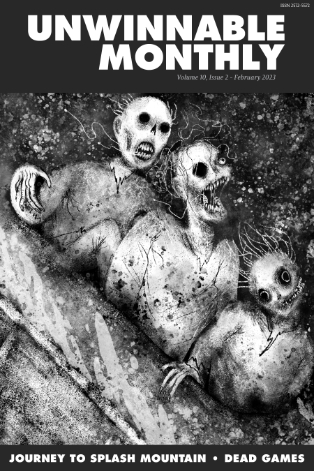
Enter the Wu-Tang

This column is a reprint from Unwinnable Monthly #160. If you like what you see, grab the magazine for less than ten dollars, or subscribe and get all future magazines for half price.
———
Selections of noteworthy hip hop.
———
1993 was a big year for me. I turned seven in March, moved to Germany in September, and (if my memory holds) was really into this t-shirt that had three moons on it. It turns out, 1993 was also a big year for a few young men from Staten Island who would, unbeknownst to me, drop one of the most important hip hop albums of all time while I was busy doing German shit: Enter the Wu-Tang (36 Chambers). Now, thirty years later, this album is one of my most played records and still on regular rotation for me when the mood strikes. But, even now, when I press play, I still wonder what it is about this specific album that would appeal to someone like me, a white kid born in white-bread Normal, IL to a couple of classics professors. How did the RZA, the GZA, Ol’ Dirty Bastard, Inspectah Deck, Raekwon the Chef, U-God, Ghostface Killah, Masta Killa and Method Man cook up something that had such wide appeal? Why did this album become my entrance into hip hop?

I don’t really remember exactly when I first heard 36 Chambers, but I suspect it was in 2005. One of my best friends from high school had developed a deep affection for the Wu-Tang Clan and pulled me along for the ride. Soon, anytime we were partying, “Up from the 36 CHAMBERS” would start echoing across the room and heads would start bopping. He even ended up spray-painting the Wu-Tang eagle onto the hood of his 1990 Acura Legend. The fact that there is no photographic evidence of that car is a true tragedy.
Fundamentally, I think the Wu-Tang Clan offered something that we midwestern kids hadn’t gotten from the land where Nelly dominated the charts. Nothing against Nelly (Country Grammar holds up) but discovering Wu-Tang felt like I was diving into a whole new world. Like the gangsta raps of 50 Cent and Dr. Dre, Wu-Tang offered a glimpse into the violence of the inner city, but it also offered an exercise in worldbuilding that wasn’t accessible through the radio. By bringing in the various samples from 1970s kung-fu movies, RZA created a sonic space that existed beyond just the violence of the lyrics. Instead, the Wu-Tang Clan became warriors, roaming the streets of Shaolin, entering into battle with unknown forces. This was hardcore hip hop with a samurai flare and a visual iconography to match. From the masks to the golden eagle, the Wu-Tang aesthetic has become legendary.

All of these elements are baked into 36 Chambers, begging a new listener to dig in deeper to what it all means. Once I was hooked on Wu-Tang, I needed to dive into the biographies of the characters, and because of the business structure of the group, there seems to be a limitless amount of new mythology to explore. RZA essentially reinvented how groups signed with labels, allowing all of the Wu-Tang members to pursue additional label relationships individually. This meant that after the success of 36 Chambers, Method Man could sign with Def Jam, Ghostface with Sony, and GZA with Geffen, release their own material, and then reform like Voltron for the next Wu album. As soon as I started listening to the Wu-Tang Clan, I didn’t have just the group discography to dig into – I also had dozens of solo albums to explore, including RZA’s projects as Bobby Digital, Ghostface’s impressive solo career (and amazing collaborations with Adrian Younge), and, most recently, Inspectah Deck’s work as Czarface.

All of this lore took on the tone of comic books – and like the best comic books, it balanced the violence with comedy. U-God might be talking about Shameek getting murdered on the street one second and the next, Method Man is joking about the most vicious ways to torture someone. Their sense of humor translates into some of their more insane music videos as well, especially “Gravel Pit” off their third studio album, The W. The members even adopted comic book names, with Method Man calling himself Johnny Blaze and Ghostface dubbing himself Tony Starks/Ironman.

This style of storytelling and worldbuilding would go on to influence innumerable rappers, including MF DOOM, Earl Sweatshirt (and Odd Future at large) and Kendrick Lamar, but that hasn’t even begun to address the musical appeal of Wu-Tang. RZA’s production is, of course, legendary at this point and a major highlight for not only the Wu-Tang Clan’s albums, but many of the solo albums as well (notably Liquid Swords, Only Built 4 Cuban Linx… and Ironman).

The entire roster of Wu-Tang members are all impeccable lyricists as well, but Ghostface Killah is a notable standout, not only delivering some of the most consequential lines but also having (perhaps) the best solo discography from the group. In terms of flow, Method Man is (in my opinion) one of the best of all time, delivering some of the smoothest verses ever across the board. And none of this starts to touch on the greatness that is ODB, the wildcard of the crew who brought a tremendous energy and vitality to every verse he was on that was often infused with humor and, frankly, some level of insanity. The diversity of the styles from all of the Wu-Tang members means that no matter what you are listening for in your hip hop – conscious raps, party music, gangsta shit – Wu-Tang has something of it for you.
2023 marks the 30th anniversary of Enter the Wu-Tang (36 Chambers) and something like the 18th anniversary of me listening to it. Putting it on again, I still can’t help but get hyped. Someone may say that it sounds dated, sounds like it’s a product of the 90s, but I would gently tell that person: “it’s ok to be wrong.” Wu-Tang’s debut is a sharp, stark, bombastic statement of intention.
———
Noah Springer is a writer and editor based in St. Louis. You can follow him on Twitter @noahjspringer.




